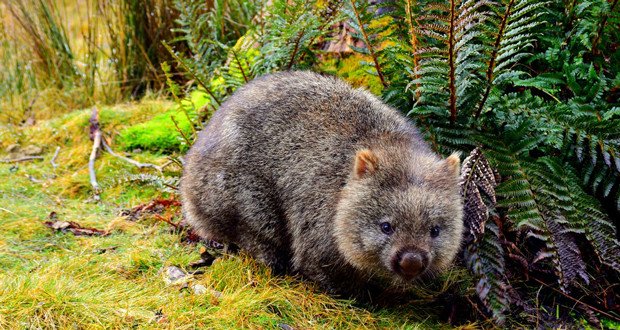
Wombats are surprisingly resilient creatures, able to thrive in various environments across Australia. Think of them as the original Australian homebodies, preferring to stay close to their burrows. Their habitats are more than just cozy spots; they play a vital role in their survival. Here’s the thing: understanding where wombats live not only helps us appreciate these animals more but also highlights the importance of conserving their natural environments.
Wombat Species and Their Habitats
Wombats are generally classified into three primary species: the **Common Wombat**, the **Northern Hairy-nosed Wombat**, and the **Southern Hairy-nosed Wombat**. Each species has its preferred habitat, which can vary from grassy plains to woodlands or even scrublands.
- Common Wombat: This species is most widespread and is found in forests, grasslands, and mountainous regions, mainly in southeastern Australia.
- Northern Hairy-nosed Wombat: Critically endangered, this wombat is mainly found in a small area of Queensland, primarily in soft, sandy soil that allows them to dig their burrows.
- Southern Hairy-nosed Wombat: Preferring the drier areas of southern Australia, this species thrives in open grasslands where food is plentiful.
Each species has adapted to its environment in unique ways. For instance, the Common Wombat’s thick, coarse fur helps it maintain body heat during chilly nights, while the Northern Hairy-nosed Wombat has a diet adapted to the specific grasses found in its limited range.
Typical Wombat Habitats
Wombats are burrowing animals, creating extensive underground networks that serve as their homes. Their burrows are a critical part of their habitat, providing shelter from predators and harsh weather. These burrows can be quite complex, with multiple entrances and lengthy tunnels.
Typically, wombats prefer loamy or sandy soils, which make digging easier. The burrows can be up to 30 meters long! Just imagine all that effort they put into crafting their cozy underground homes. Honestly, it’s like they’re little architects, designing their own retreats.
These burrowing habits don’t only help wombats; their tunnels create pathways for other animals, promoting biodiversity in their ecosystems. So, when wombats dig around, they’re not just helping themselves—they’re helping the whole neighborhood!
Geographical Distribution of Wombats
Wombats are unique to Australia, but they can be found across various states. Their distribution is mainly focused in the southeast, including parts of Tasmania and New South Wales, which offer a good mix of food and shelter.
The **Common Wombat** is the most widely distributed species. It’s found in *Victoria*, *New South Wales*, and *Tasmania*. In contrast, the **Northern Hairy-nosed Wombat** is only found in a small area of Queensland, making its survival critical. The **Southern Hairy-nosed Wombat** occupies regions in *South Australia* and parts of *Western Australia*.
You might be wondering why the Northern Hairy-nosed Wombat is so limited in range. Habitat destruction, competition with livestock, and changes in land use have drastically reduced their numbers and living areas. This situation emphasizes the importance of protecting their natural habitats.
Wombat Behavior and Environmental Adaptations
Wombats are primarily nocturnal, meaning they are active at night. During the day, they tend to stay hidden in their burrows to conserve energy and protect themselves from the heat. This behavior is crucial for their survival, especially in Australia’s sometimes harsh climates.
You might find it interesting that wombats also have a unique way of handling their diet. They are herbivores, eating mainly grasses and roots. Their digestive systems are specially adapted to break down tough plant fibers, which helps them extract the nutrients they need. It’s like they have their own little factory working 24/7 to keep them healthy!
Moreover, wombats have strong, flat teeth designed for grinding. This allows them to munch on various vegetation, adapting to whatever their habitat provides. This adaptability is critical for thriving in the different environments they call home.
Threats to Wombat Habitats
Despite their remarkable adaptability, wombats face several threats that jeopardize their habitats. **Habitat destruction** is perhaps the most significant issue. Urban development, agriculture, and mining can lead to deforestation and soil degradation, making it harder for wombats to find suitable living spaces.
Additionally, factors like **climate change** play a role. Altered weather patterns can lead to droughts or heavy rains, which impact the availability of food and the stability of their burrows. You can imagine how unsettling it must be for them to navigate these changes—like trying to find a cozy corner in a constantly shifting landscape.
Disease is another concern. Wombats can fall prey to conditions like mange, which not only affects their health but can also influence their distribution by forcing them out of familiar areas in search of better conditions.
Conservation Efforts for Wombat Habitats
Given the threats wombats face, conservation efforts are crucial. Various organizations work tirelessly to protect their habitats and raise awareness about their situation. Conservation programs often focus on restoring ecosystems, creating protected areas, and promoting sustainable land-use practices.
For instance, efforts in *Queensland* aim to establish protected zones for the Northern Hairy-nosed Wombat, ensuring they have safe environments to thrive. Other initiatives include education campaigns to foster public support for wombat conservation and encourage responsible land management.
You might be surprised to learn that even simple actions, like supporting wildlife-friendly practices in farming or volunteering for local habitat restoration projects, can make a difference. Together, we can help ensure these charming creatures continue to roam the Australian landscape.
Wombats are more than just cute, furry animals; they are an essential part of the Australian ecosystem. From their unique burrowing habits to their ability to adapt to various environments, these marsupials showcase the incredible diversity of wildlife in Australia. By understanding where wombats live and the challenges they face, we can work together to protect their habitats for future generations.
So, the next time you think about wombats, remember the cozy burrows they create and the beautiful landscapes they inhabit. With just a little effort, we can be good neighbors and help preserve the homes of these delightful creatures. Let’s keep the wombat legacy alive, one burrow at a time!
